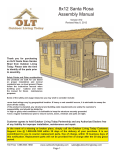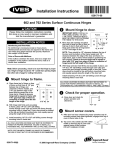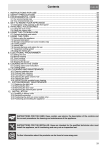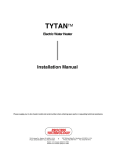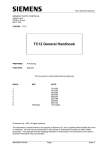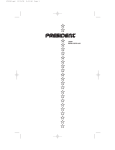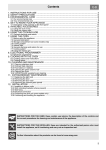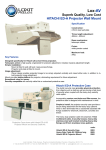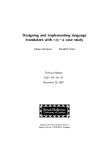Download Survey & Installation Manual - Bereco Timber Windows and Doors
Transcript
Survey & Installation Manual Timber Windows & Doors FSC SUPPLIER SA-COC-0975 BER Contents 1. Surveying & Measuring Height Measurement 1. Survey & Measuring . . . . . . . . . . . . . . . . . . . . . . . . . . . . . . . . . . . . . . . . . . . . . . . . . .3 This survey and installation manual is intended as a general guide to measuring and installing Bereco products. By virtue of the wide variety of building types, ages and construction methods, it cannot offer solutions to cover all circumstances. The final responsibility for accurate dimensions, correct specification and compliance with all statutory regulations (including health and safety), codes of practice, contract design management requirements and all other best practice procedures rests with the Approved Installer. The height of the aperture should be measured at three points; Left Middle Right The smallest dimension should be used to determine the height (See Figure 1). 1.1 General Regulations . . . . . . . . . . . . . . . . . . . . . . . . . . . . . . . . . . . . . . . . . . . . . . . . . . . .3 1.2 Measuring Windows in new-build situations . . . . . . . . . . . . . . . . . . . . . . . . . . . . . . . . . .3 1.2.1 Flat Windows (no reveal, with or without Cavity Closures) . . . . . . . . . . . . . . . . . . . . . .3 1.2.2 Manufacturing Size Flat Windows (no Reveal, with or without Cavity Closures) . . . . . .4 1.2.3 Flat Windows (with Reveal, with or without Cavity Closures) . . . . . . . . . . . . . . . . . . . .4 1.2.4 Manufacturing Size Flat Windows (with Reveal, with or without Cavity Closures) . . . .5 1.2.5 Bay Windows in new-build situations . . . . . . . . . . . . . . . . . . . . . . . . . . . . . . . . . . . . . .5 Diagonal Measurement 1.2.6 How to measure Bay windows . . . . . . . . . . . . . . . . . . . . . . . . . . . . . . . . . . . . . . . . . . .5 1.2.7 Bereco Ltd Bay Ordering Form . . . . . . . . . . . . . . . . . . . . . . . . . . . . . . . . . . . . . . . . . . .6 1.3 Measuring Windows in refurbishment situations . . . . . . . . . . . . . . . . . . . . . . . . . . . . . . .6 1.3.1 Flat Windows (no reveal) . . . . . . . . . . . . . . . . . . . . . . . . . . . . . . . . . . . . . . . . . . . . . . . .6 1.3.2 Flat Windows (existing reveal) . . . . . . . . . . . . . . . . . . . . . . . . . . . . . . . . . . . . . . . . . . . .6 1.3.3 Manufacturing Size Flat Windows (either with or without existing reveal) . . . . . . . . . . .6 1.3.4 Bay windows in refurbishment situations . . . . . . . . . . . . . . . . . . . . . . . . . . . . . . . . . . . .6 1.4 Measuring Doors in new-build situations . . . . . . . . . . . . . . . . . . . . . . . . . . . . . . . . . . . . .7 1.4.1 Flush & French Doors (no reveal, with or without Cavity Closures) . . . . . . . . . . . . . . . . .7 1.4.2 Manufacturing Size Flush & French Doors (no reveal with or without Cavity Closures) .7 1.4.3 Flush & French Doors (Reveal, with or without Cavity Closures) . . . . . . . . . . . . . . . . . . .8 1.4.4 Manufacturing Size Flush & French Doors (Reveal with or without Cavity Closures) . . .8 1.5 Measuring and Manufacturing Sizes for Doors in refurbishment situations . . . . . . . . . . .8 1.5.1 Flush & French Doors (no existing reveal) . . . . . . . . . . . . . . . . . . . . . . . . . . . . . . . . . . . .8 1.1 General Regulations If the diagonals differ, the window size should be reduced accordingly so that when the new frame is offered up to the aperture it can be installed square, normally with the aid of packers in the appropriate places. If the diagonals vary by more than 10mm, additional outer trims may be required to conceal the gaps between the frame and aperture. The customer should be advised of this and agree to it prior to order confirmation. Windows are vital elements of houses and dwellings and therefore need to comply with various regulations in both their stand-alone performance as well as in built-in situations. The following regulations will give information regarding these regulations: Conservation of Fuel & Power England & Wales AD L1A & AD L1B Scotland Part J Northern Ireland Technical Booklet F England & Wales Scotland Northern Ireland Means of Escape from Fire England & W ales AD B Scotland Part M Northern Ireland Technical Booklet E Glazing (Safety) England & W ales AD N Scotland Section 4 Northern Ireland Technical Booklet V Protection from Falling England & Wales AD K Scotland Section 4 Northern Ireland Technical Booklet H Ventilation AD F Section 3 Technical Booklet K Cill Extensions The distance from the face of the building to the front face of the cill extension should be no less than 25mm. The distance of the internal face of the frame should be at least 30mm into the cavity to comply with Part L of Building Regulations. AD = Approved Document Guidance on Building Regulations can be found on the following websites: for England & Wales: Department for Communities & Local Government: www.communities.gov.uk for Scotland: Scottish Building & Standards Agency: www.sbsa.gov.uk for Northern Ireland: Department for Finance & Personnel: www.communities.gov.uk All Dimensions need to be taken in the place where the windows will sit once installed. 1.5.2 Flush & French Doors (existing reveal) . . . . . . . . . . . . . . . . . . . . . . . . . . . . . . . . . . . . . .8 1.6 Measuring Special Doors and Doors in Special Situations . . . . . . . . . . . . . . . . . . . . . . . . .9 1.6.1 Sliding Patio Doors HS . . . . . . . . . . . . . . . . . . . . . . . . . . . . . . . . . . . . . . . . . . . . . . . . . .9 1.6.2 Tilt & Slide Doors PSK . . . . . . . . . . . . . . . . . . . . . . . . . . . . . . . . . . . . . . . . . . . . . . . . . .9 Figure 1 Windows and Doors are non-load-bearing elements and structural support, like lintels are necessary. Figure 2 1.2 Measuring Windows in new-build situations 1.6.3 Folding - Sliding Doors FS . . . . . . . . . . . . . . . . . . . . . . . . . . . . . . . . . . . . . . . . . . . . . . .9 2.1 Fixing . . . . . . . . . . . . . . . . . . . . . . . . . . . . . . . . . . . . . . . . . . . . . . . . . . . . . . . . . . . . . . . .9 2.2 Support . . . . . . . . . . . . . . . . . . . . . . . . . . . . . . . . . . . . . . . . . . . . . . . . . . . . . . . . . . . . .10 2.3 Sealing . . . . . . . . . . . . . . . . . . . . . . . . . . . . . . . . . . . . . . . . . . . . . . . . . . . . . . . . . . . . . .10 2.4 Coupling . . . . . . . . . . . . . . . . . . . . . . . . . . . . . . . . . . . . . . . . . . . . . . . . . . . . . . . . . . . .10 3. Final Inspection . . . . . . . . . . . . . . . . . . . . . . . . . . . . . . . . . . . . . . . . . . . . . . . . . . . . .11 4. Site Re-Glazing . . . . . . . . . . . . . . . . . . . . . . . . . . . . . . . . . . . . . . . . . . . . . . . . . . . . . .12 4.1Removing Timber Beads . . . . . . . . . . . . . . . . . . . . . . . . . . . . . . . . . . . . . . . . . . . . . . . . .12 1.2.1 Flat Windows (no reveal, with or without Cavity Closures) The way to measure flat windows is exactly the same, regardless of the use of pre-formed Cavity Closures but these Formers are required during construction and therefore assure correct building. In this case, no measurements of the final opening need to be taken. Formers determine the structural opening size and therefore the window size, which guarantees a perfect fit. Cavity Closures can be made to agreed structural sizes. Bereco simply deducts a tolerance to achieve a window size. Overall Frame Size 2. Installation . . . . . . . . . . . . . . . . . . . . . . . . . . . . . . . . . . . . . . . . . . . . . . . . . . . . . . . . . .9 Structural Opening Size 1.6.4 Doors coupled to windows . . . . . . . . . . . . . . . . . . . . . . . . . . . . . . . . . . . . . . . . . . . . . .9 4.2 Removing Glass . . . . . . . . . . . . . . . . . . . . . . . . . . . . . . . . . . . . . . . . . . . . . . . . . . . . . . .12 4.3 Replacing Glass & Beads . . . . . . . . . . . . . . . . . . . . . . . . . . . . . . . . . . . . . . . . . . . . . . . . .12 Width Measurement 5. Health & Safety . . . . . . . . . . . . . . . . . . . . . . . . . . . . . . . . . . . . . . . . . . . . . . . . . . . . .12 The width of the aperture should be measured at three points; Top Middle Bottom The smallest dimension should be used to determine the width (See Figure 1). Bereco Delivering the Difference 2 M in 30m m Figure 1 3 Bereco Delivering the Difference 30 m Note: Please always provide a template when shaped / angled / arched windows are ordered. Without Cavity Closures When no Cavity Closures are used tolerances between the structural opening size and the overall window size need to be taken into account. This is necessary to allow the window to be fixed to walls and to insulate all window – wall connections. Should the reveal used be more than 10mm bigger for either jambs or heads than the dimensions shown above, additional timber packers can be ordered to accommodate for it. Reveal Size 1.2.3 Flat Windows (with reveal, with or without Cavity Closures) Remember: Where the final wall finish is to be render, the thickness needs to be included in the overall cover prior to ordering (ie. the final window size will be smaller in both width and height). Worked example: Daylight sizes are 900mm wide x 1500mm high, Sliding Sash window Cords & Weights, reveal size = 100mm on jambs and 50mm on head Window Sizes: Width = 900mm + 2 x 95mm1 = 1090mm (overall width of window) Height = 1500mm + 41mm1 –10mm2 = 1531mm (overall height of window) Figure 7.1 Internal Structural Opening Width Overall Frame Size (Width) 95 Window Daylight Width Measuring bay windows is not as difficult as it may seem. The most important rule in order to get the windows right is continuity in measurement, where dimensions are taken the same way throughout. The best ways to measure bay windows are: Along the external face of the internal brick / blockwork Along the internal face of the external brick / blockwork (favoured, see Figure 8) Along the external face of the external brick / blockwork To avoid errors and unnecessary questions it is important to stick to either one of these options and not to mix between them. It is also necessary to know, which wall detail (Figure 6.2 / 7.2) is chosen and what size of cavity is used for the building. Be careful with this calculation that the reveal size is not either the same size or smaller than the maximum cover – there is still some tolerance (usually 5mm all-round) required to allow for a tight but easy fit. In this case the maximum cover should be reduced to suit the reveal depth. Again, when Cavity Closures are used it is fairly straightforward to determine window sizes, similar to straight-through openings. Bereco will assist you in this manner as best possible. If in doubt of how to measure bay windows or for further technical details please contact the Bereco sales office 01709 838188. 1.2.5 Bay Windows in new-build situations Bay windows whether square or angled require careful consideration when planning building detail and installation. The Building Regulations (Approved Document L) require that the thermal performance around openings achieve levels that some traditional methods of bay window installation cannot meet. In some situations a so-called ‘birds-mouth’ detail was used to set the bay window into the corner of the brickwork. Most of these details are unacceptable under current Regulations as they usually create a ‘thermal bridge’, which causes heat loss and therefore invalidates achieved energy performance of the whole element. In this manual we consider 2 different ways to overcome this problem. However, there are various ways to avoid thermal bridges but the most elegant ways are shown in figures 5, 6, 7. Front Bay Width Overall Width of Bay Window overall projection of Bay Re tu rn 4 rn tu Re y Ba Overall Width of Bay Window overall projection of Bay Front Bay Width min 30mm Figure 5.1 Ba y Front Bay Width It is important to take some dimensions at various points (for example the overall projection) in order to spot any abnormalities. Height dimensions need to be taken from the cill to the lintel at various points similar to the measurement of flat windows. Figure 5.2 Bereco Delivering the Difference 2 Figure 9 shows dimensions that need to be taken when bay windows are ordered (please use Bereco bay window ordering form). In this case all dimensions are taken along the inside face of the external block / brickwork. Figure 9 It is not crucial to measure diagonal dimensions 1 and 2 for square bay windows, however it gives the opportunity to check if the 90 degrees angles are correct (they are if both diagonals give the same dimension). Reveal Size Figure 4 1 on ensi l Dim gona Dia D iago nal Dim ensi on y Ba External Structural Opening Width (Daylight Size) 95 Figure 7.2 1.2.6 How to measure Bay windows rn tu Re The general rules for measuring windows where a reveal has been formed are the same as for flat windows with straight-through openings. That means width and height measurements should also be taken in 3 places and diagonal dimensions should be checked. The difference is the place where these dimensions are taken. To determine the correct window size it is very important to allow for the right cover. In order to do that structural sizes required are daylight sizes, ie. dimensions between the external brickwork as shown on figure 3 and 4. In order to achieve the correct window size the correct reveal dimensions are required (for example 100mm jambFigure 3 reveal / 50mm head reveal). Figure 6.2 Figure 6.2 2 = 10mm tolerance used for cement bed at cill Product Max Cover Jamb Max Cover Head Tilt & Turn 10mm 5mm Lipped Casement 30mm 0mm Flush Casement 35mm 0mm Reversible 10mm 5mm SS Spiral Balance 41mm 41mm SS Cords & Weights 95mm 41mm Note: Please always provide a template when shaped / angled / arched windows are ordered. Overall Frame Size Width = daylight width + 2x jamb cover Height = daylight height + head cover – tolerance on cill (usually 5/10mm) 1 = maximum cover for jambs and head Table 1: Max Reveal Cover for Windows The overall tolerances for flat windows should be 10mm in both width and height (5mm all-round) to allow for easy handling and fixing as well as a ‘tight fit’. Further information can be found in British Standard BS 644. Structural Opening Size (Daylight Size) Figure 6.1 Retrun Bay When Cavity Closures are used the actual Cavity Closure determines the window size so no site measures are required. Dimensions for the Closure are taken off plans. A major advantage of using Cavity Closures is that a perfect fit can be achieved (correct tolerances are allowed for). Moreover, all windows can be ordered in advance. As a result the building process will not be held up by delays. Cavity Closures can be ordered by Bereco – please contact the office for details. Both dimensions of the external brickwork and the required cover determine the final window sizes. The general rule to calculate overall width and height is: 5 Ba y With Cavity Closures 1.2.4 Manufacturing Size Flat Windows (with Reveal, with or without Cavity Closures) Re tu rn By the use of pre-formed Cavity Closures for the building it is again straight forward to achieve perfectly fitting windows since all openings are created with formers as they determine window sizes. Planned dimensions can be taken off drawings however, it is very important to know the correct reveal size in order to allow enough tolerance for both aesthetics and functional reasons (Casement windows for example wouldn’t open if tolerance was too little). Table 1 shows the maximum coverage for different Bereco window types. 30 min m m 1.2.3 continued Retrun Bay 1.2.2 Manufacturing Size Flat Windows (no reveal, with or without Cavity Closures) Bereco Delivering the Difference Figure 10 Similar to a survey of existing flat windows without reveal it is important for existing windows with reveal to measure both width and height at various places and all dimensions again need to be wall-to-wall dimensions (ie. all render needs to be removed). It is also necessary to measure the existing reveal size at both jambs and head. This is best possible with a metal ruler or a screwdriver. Detailed information regarding the cill detail / required cill extension is necessary to assure full performance of all new windows. 1.2.7 Bereco Ltd. Bay Ordering Form Please always comment on: • Where the dimensions have been taken from (internal / external face of internal / external blockwork) • What size of Cavity is chosen for the building • Which wall detail is going to be used (see Figures 5 / 6 / 7) • What cill is going to be used (eg. sloped brick cill / pre cast concrete / stone cill) • What external wall finish will be used • What cill extension size is required 1.3.3 Manufacturing Size Flat Windows (either with or without existing reveal) Once the structural dimensions have been taken, tolerances need to be added in order to allow a perfect fit. In this circumstance the same rules are valid as those for windows in a new-build situation. Please allow for sufficient tolerances and beware of maximum cover for existing reveals (see table 1). Note: For bay windows we recommend forwarding structural opening sizes instead of final window sizes to accommodate for additional requirements. The technical team at Bereco will assist you in this. 1.3 Measuring Windows in refurbishment situations 1.3.4 Bay windows in refurbishment situations The steps to measure bay windows for refurbishment situations are the same as for flat windows, however it might be a bit more difficult to get to the correct wall-towall dimensions. Therefore render / plaster needs to be removed at various places in order to take the dimensions correctly. Furthermore it is necessary to know in what way the bay window is connected to the walls and what the wall is made of (ie. size of cavity, bricks and cill details). 1.3.1 Flat Windows (no existing reveal) Replacement windows are usually measured and ordered before the existing windows are taken out and extra care is required during site-measure. Width Measurement The width of the aperture should be measured at three points; Top Middle Bottom The smallest dimension should be used to determine the width (See Figure 1). Note: Please always provide structural opening sizes rather than calculating final window sizes for bay windows in refurbishment situations. It is also always helpful for our technical team if photographs can be supplied for any difficult situation. Height Measurement Doors of any kind, like windows, are not designed to be load bearing. Please contact your structural engineer for advice, especially when large door sets like Folding-Sliding Doors or Sliding Patio Doors are considered. General Regulations (Building Regulations) are valid for both windows and doors. Please refer to the Building Regulations mentioned earlier in this manual. 1.4.1 Entrance & French Doors (no reveal, with or without use of Cavity Closure) If Cavity Closures are used (they can be ordered directly through Bereco) then there is no survey required since all sizes are determined by the Closures. If no Cavity Closures are used all dimensions should be taken like window sizes. Bereco Delivering the Difference Table 2: Maximum floor cover for door thresholds (please see Brochure for details) Width Measurement The width of the aperture should be measured at three points; Top Middle Bottom The smallest dimension should be used to determine the width (See Figure 1). Standard Site-Coupling Mobility (Option 1) (Option 2) (Option 3) Flush Door open in 30mm 30mm 0mm Flush Door open out 35mm 35mm 0mm French Door open in 30mm 30mm 0mm French Door open out 35mm 35mm 0mm Sliding Door HS 40mm N/A N/A Tilt & Slide Door PSK 0mm N/A N/A Folding Sliding Door FS See figure 14 Height Measurement The height of the aperture should be measured at three points; Left Middle Right The smallest dimension should be used to determine the height (See Figure 1). 1.4.2 Manufacturing Size Entrance & French Doors (no reveal, with or without Cavity Closures) As with the windows, fitting tolerances need to be deducted when structural openings are measured in order to get to overall frame sizes. The general tolerances are 5mm all-round or 10mm in both width and height. If the threshold is to be sunk into the floor in order to reduce the step this dimension needs to be added once fitting tolerances have been deducted. Figure 11 shows that the width measurement is taken between structural walls and it shows that it is very important to consider the final wall finish and its thickness in order to allow the door to open properly. Usually the same cover is used on Jambs and Head of the doorframe. 5m m to le ra n c e S in g le F lu s h D o o r O p e n In S in g le F lu s h D o o r O p e n O u t 19m m S kirting board 19m m Skirting board 12.5m m P lasterboard 12.5m m Plasterboard 5m m dot/dab (norm ally 15m m ) 5m m dot/dab (norm ally 15m m ) Internal Blockw ork Internal Blockw ork 4 The height of the aperture should be measured at three points; Left Middle Right The smallest dimension should be used to determine the height (See Figure 1). There are various types of thresholds available, depending on access and building requirements. For some of the thresholds (please refer to Bereco Brochure) it is possible to sink them into the floor to reduce the final step. In order to do this screed needs to be cut (or space needs to be allocated beforehand) and the overall frame height needs to be increased by the size that the threshold is sunk in. Door thresholds must not be sunk in too much – especially with open in doors there is a danger that doors won’t open once tiling / timber flooring or carpets are finished. Table 2 shows the maximum recommended size a door threshold should be sunk into the floor. Figure 12 shows how door thresholds can be sunk into the floor (in this case 30mm). It is always important to know about the final wall finish (render / brick / cladding) in order to avoid problems (particularly with open out doors). Our technical team can assist you if you have any question. 66 5m m tolerance 5m m tolerance E xternal B lockw ork External Blockw ork s/o w idth m easured to w all s/o w idth m easured to w all Figure 11 6 7 5m m to le ra n c e smallest structural height = 2100mm 1.3.2 Flat Windows (existing reveal) Height measurements always need to be taken from the bottom of the lintel to the top of the Finished Floor, at 3 different places as indicated above. 1.4 Measuring Doors in new-build situations overall frame height = 2120mm It is important that the external wall-to-wall dimensions are taken and not the old frame sizes. In order to do so, render and sealing (mastic) need to be removed prior to the measure. It is also necessary to inform Bereco about the existing cill detail and required cill extensions. Please always check for reveals that might eventually exist. Figure 12 3 0 m m s u n k in to flo o r Bereco Delivering the Difference Weather Board 1.4.3 Flush & French Doors (Reveal, with or without use of Cavity Closure Measuring doors with a reveal wall detail is similar to measuring windows with a reveal; the same information is required. That means the overall dimension from brick to brick is required as well as the size of reveal. When Cavity Closures are used there is again no measure required since the Closure acts like a Former and window sizes are determined with the Closure. The reveal sizes and the Cavity width are necessary to order Cavity Closures. It is very important (regardless of the use of Cavity Closures) that the maximum cover for doorframes is not exceeded. Table 3 gives advice on the maximum cover for doors. That is the overall cover (including reveal and final wall finish). Flush Flush French French Sliding Tilt & Folding Door Door Door Door Patio Slide Sliding open open open open Doors Doors Doors in out in out (HS) (PSK) (FS) Max 0mm Jambs 45mm 20mm 60mm (packer 50mm 60mm 60mm Cover rqd) Bereco Delivering the Difference Newbuild Situation All Bereco windows and doorsets should be fitted into preformed openings, which are at least 10mm larger (5mm all round) than the overall frame size. In the case of new buildings or extensions, frames should not be built in as the work proceeds. Frames should be installed plumb and square using metal fixings or perimeter battens and Figure 16 shows typical fixing centres. Please use spirit levels to assure windows and doorsets are installed plumb and square. A minimum of two fixing points per side (depending on height) should be used. These should be positioned at between 100mm & 200mm in from each corner. Additional fixings will depend on the size of the frame as follows: Frame height up to 1000mm = 2 per side 1000mm to 1600mm = 3 per side 1601mm to 2100mm = 4 per side Over & above maintain 450mm centres. Where the frame width exceeds 1800mm or is formed by two or more coupled units, fixings should be provided at the head and cill. 1.6.3 Folding – Sliding Doors FS PSK Tilt & Slide Doors are easy to measure and should be handled the same way like any other door. That means it is necessary to think about reveals and final wall finishes. There are 2 threshold options, which both can be sunk into the floor (see tables 2 & 3 and figure 14). As these doors fold to the inside it is also necessary to think about Aluminium Mobility Threshold not availible with all models (see brochure for details) Standard Timber Threshold availible with all models sunk into Screed by 21mm leaving 18mm step sunk into Screed by 40mm leaving 62mm step 18 Top of 20mm Flooring FFL Top of 20mm Flooring FFL 11 x 68 116 Figure 14 150mm Approx. 450mm Approx. Centres 450mm Approx. Centres 1.6.4 Doors coupled to windows When doors are coupled to windows (for example Entrance Doors) the overall aperture needs to be measured as one. The procedures to measure are exactly the same as described before, however, a few more 8 Figure 15 C1 2.1 Fixing 1 reduced to 15mm when vent is provided Should the required cover exceed the recommendations there is a chance to order additional timber packer to allow for a tight and correct fit. A2 This survey and installation manual is intended as a general guide to measuring and installing Bereco products. By virtue of the wide variety of building types, ages and construction methods, it cannot offer solutions to cover all circumstances. The final responsibility for accurate dimensions, correct specification and compliance with all statutory regulations (including health and safety), codes of practice, contract design management requirements and all other best practice procedures rests with the Approved Installer. the internal plasterboards / skirting boards and tolerances towards walls. Please contact Bereco for assistance. Due to their size it is recommended to seek assistance during the measuring process in order to avoid mistakes. Max 0mm 0mm Head 45mm (packer 60mm (packer 50mm1 60mm 72mm Cover rqd) rqd) W2 E2 PSK Tilt & Slide Doors are easy to measure and should be handled the same way like any other door. That means it is necessary to think about reveals and final wall finishes. It is not possible to sink the threshold of these doors into finished floor (see tables 2 & 3). Due to their size it is recommended to seek assistance during the measuring process in order to avoid mistakes. 2. Installation D1 F2 1.6.2 Tilt & Slide Doors PSK The steps to measure doors for refurbishment situations are exactly the same as for replacement windows. That means both width and height need to be measured in different places once plaster has been removed in order to provide wall-to-wall sizes. Do not measure the existing frame. It is unlikely that thresholds will be sunk into the floor when doors are replaced so height dimensions should be taken between lintel and finished floor (that is below tiles / carpet / timber flooring). However, if sinking in is still required please follow the steps outlined above. Once these dimensions have been taken fitting tolerances need to be deducted. Be careful that the final wall finish does not exceed the recommended dimensions for frame covers (see table 3). D1 C2 A1 B2 1.5.1 Flush & French Doors (no existing reveal) F1 1.5 Measuring and Manufacturing Sizes for Doors in refurbishment situations The measurement of doors with existing reveals is as simple as measuring doors without. The required dimensions are again to be taken between the external brickwork of both sides. It is important to know reveal sizes, which can be measured best with a metal ruler. In order to measure the correct hard opening sizes it is necessary to remove existing render prior to the measure. The overall door sizes can be easily calculated by adding the required reveal cover, which should not exceed dimensions shown in table 3. Please also accommodate for sufficient fitting tolerance (5mm all-round) when door dimensions are calculated. Table 3: Maximum Reveal Cover W1 HS Sliding Patio Doors are easy to measure and should be handled as any other door. That means it is necessary to think about reveals / final wall finishes and whether or not thresholds are going to be sunk into the finished floor (see tables 2 & 3). Due to their size, however, it is recommended to seek assistance during the measuring process in order to avoid mistakes. 1.5.2 Flush & French Doors (existing reveal) Lintel D2 21 Figure 13 Lintel 1.6.1 Sliding Patio Doors HS 59 Internal Blockwork dimensions are necessary in order to achieve a perfect fit. Figure 15 shows which dimensions should be taken during measure. In this case it is advisable to provide structural opening sizes rather than calculating final window / door sizes. B1 Measuring doors in new-build situations and when a reveal is formed is as straightforward as with windows in the same situation. That means that the external brick-tobrick dimensions need to be taken and reveal sizes and cover needs to be considered (see worked example page 5 and table 3). Please also consider by how much – if at all – thresholds are going to be sunk into the floor. 62 19mm Skirting board 12.5mm Plasterboard 5mm dot/dab (normally 15mm) 1.6 Measuring Special Doors and Doors in Special Situations E1 1.4.4 Manufacturing Size Flush & French Doors (Reveal, with or without Cavity Closures) 40 Figure 13 shows why it is important to inform Bereco about the final wall finish. Additional fixings to windows 1800mm wide and above. 450mm Approx. Centres 150mm Approx. Figure 16 9 Bereco Delivering the Difference Refurbishment Situation Fixing will normally be through the frame; although fixing lugs, which facilitate fixing from inside the building can also be used. Purpose made nylon fixings are available. These utilise the same diameter hole through the frame and substrate, and are normally supplied together Wall Window with screws. Alternative fixings include a proprietary screw device, which enables the window position to be adjusted on the fixing itself (See figure 17). Figure 17 Fixings should not be overtightened and surrounding brickwork should abut the frame Gap adjusted by turning thread in window only lightly so that no frame distortion can occur. Before final fixing, check that opening sashes have equal clearance on both sides. Mullions of multi-light windows MUST be supported to avoid sagging. 2.3 Sealing 3. Final Inspection To prevent air infiltration between the window/door and adjacent wall the gap between the window and wall should be sealed. Polythene backed sealing strips can be fitted prior to installation or alternatively an expanding foam seal or mineral wool can be fitted after installation has been completed. When using gap-filling foams avoid injecting excessive amounts as this may deflect the jambs and FL induce vertical bow. Finally, a silicone or polysulphide based sealant (Approved to BS 5889) should then be applied (see Figure 19). Following completion, a final inspection should be carried out to ensure that the installation is of the highest standard. We recommend that there should be a formal procedure for checking the work, using a checklist similar to the one shown below. We also recommend that these checks should be carried out in the presence of the customer, who should be familiarised with the operation, and Bereco operating and maintenance instructions should be left with the customer. Area to be checked OK Yes/No Visual Appearance 1 Windows installed plumb, square and vertical. 2 Exposed faces including beads free from surface damage. 3 Window and frame clean and all protective film removed. 4 Check for damage around surrounding aperture. 5 Check all internal trims are installed correctly. 6 Check the site is clean and all debris is removed. 1 Glazing as specified. 2 No cracks or scratches on glass, or signs of unit failure. 3 Obscure glass is oriented the correct way. Figure 19 2.4 Coupling When windows are coupled to doors (see figure 15) they need to be coupled before installation (see figure 20). Bereco provides jointing slips and cover facings. Additional coupling material (screws, screw covers etc) is supplied by the approved installer. Jointing slips need to be glue-fixed in relevant grooves and the overall construction has to be pre-drilled and screw-fixed at various places as shown in figure 20. 2.2 Support Packing pieces should be located at all fixing points. If additional packing pieces are required to raise the position of the frame in the aperture or to compensate for the base of an aperture that is not level, all mullions must be supported, as shown in figure 16 & 18 If additional packing pieces are required to raise the position of the frame in the aperture or to compensate for the base of an aperture that is not level, all mullions must be supported, as shown in Figure 16 & 18. Particular care is necessary when providing packing to vertical sliding windows, where even minor distortions can prevent the movement of the sashes or introduce excessive clearance. When fitting packing, the correct operation of sashes should be checked prior to fixing and a mortar bed can be used to provide continuous support at cill level. Glazing Operation internal & external cover facings supplied loose by Bereco Jointing Slips provided loose Figure 20 Sight Lines Figure 18 1 All opening sashes open and close correctly 2 No air gaps between seals and frames. 3 No scraping or rubbing between Espagnolette and keepers. 4 When doors slam, no bounce, or outer frame movement 5 All operation gear correctly lubricated. 6 All hardware attached with correct number of fixings. 1 Visually correct. 2 Adjacent vents aligned. 1 Sealant to be continuous around frame run. 2 No excess sealant to be present on frame faces. Pre-Drill and screw Sealing Additional support under mullions Additional support be provided MUST under mullions MUST when packing be provided. pieces are used 150mm Max Inspection Bay Windows 1 Ensure no settlement of structure when temporary supports removed. 2 Check that flashings and DPC have not been disturbed or damaged. 150mm Max Bereco Delivering the Difference 10 11 Bereco Delivering the Difference 4. Site Re-Glazing Silicone the edge between glass and timber on both the inside and outside with correct coloured silicone (BS 5889 approved). Spray lubricated water on the silicone and use a PVC-scraper to smoothen surface as shown in figure 24. 4.1 Removing Timber Beads Where de-glazing is necessary, cut the silicone along the glass-timber edge with a utility knife and remove the silicone (figure 21). Remove all timber beads, starting with the longest ones by tapping the bead towards the centre of the pane using a plastic glazing chisel (see Figure 22). This should separate the bead from the sash or frame. The chisel can then be used to prise it off completely. Repeat this process for the remainder of the beads. Remove any nails from the glazing rebate. Nails that are left in the glazing bead should be pulled through the back of the bead with a pair of pincers to avoid break out through the face. Remove any silicone from the beads. step 1: silicone (BS 5889 approved) 1 Figure 24 2 step 2: spray with lubricated water and smoothen surface with scraper For further glazing information please refer to BS 8000 Part 7 1990, BS6262 Glazing in Buildings & NHBC Standards Charter 6.7 January 1999 edition as of January 2000 Utility knife Security Tape cut security tape Cut silicone on both inside and outside use glazing chisel towards the centre of the pane with a hammer 5. Health & Safety Bereco windows and doors come packed in a loose polythene bag and securely strapped on wooden pallets. Mechanical Offloading facilities are provided when elements are delivered to site using a Moffet-Forklift vehicle. The weight of each item is shown on the sales confirmation and there are health and safety instructions attached to each element. Figure 22 Figure 21 4.2 Removing Glass Before removing the sealed unit, the double-sided security tape must be cut from the outside and all glazing blocks need to be removed using the glazing chisel as lever. The glass should then be removed from the inside (from outside for Reversible windows) It is the responsibility of the approved installer to make him/her self aware of any Health & Safety and Construction Design and Management Regulations that may apply to the work he/she is undertaking. 4.3 Replacing Glass & Beads Remove the remainder of the silicone and the security tape from the glazing upstand. Where security tape has been damaged replace it with new tape. Place the glass into the glazing check, ensuring equal spacing all around. Correct spacing of the glass blocks is shown in Figure 23. The centre of the glazing block should be approximately 100mm from the corner. Beads should be replaced fixing the smallest ones first then the longer ones, ensuring compression on the glazing tape. Nails should be punched and filled with appropriate coloured filler and the face of the bead should be repainted/stained. Unit 5 Aspen Court Centurion Business Park Bessemer Way Rotherham S60 1FB Figure 23 Bereco Delivering the Difference 12 Tel: 01709 838188 Fax: 01709 838330 Email: [email protected]









